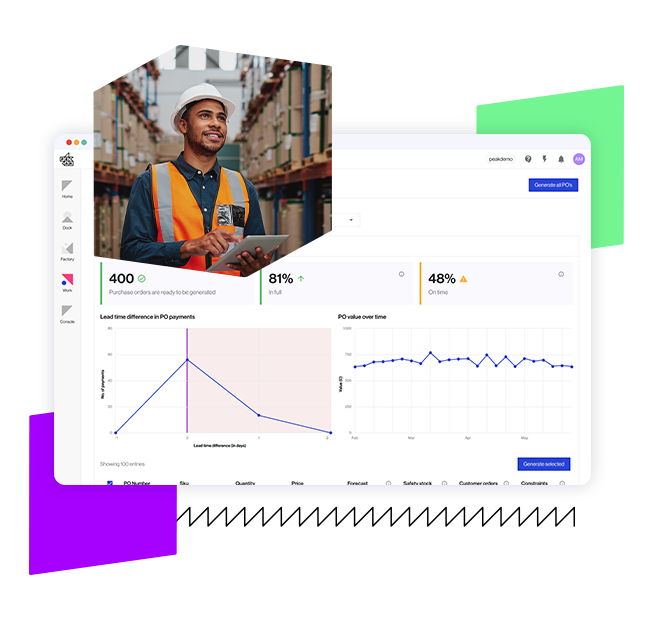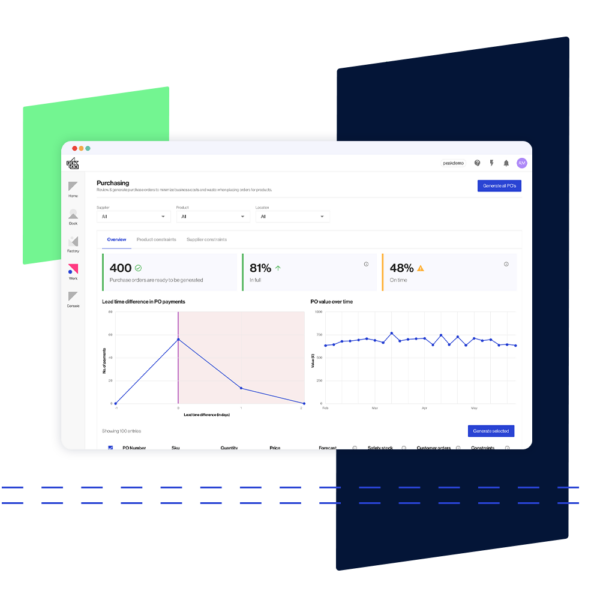
Purchasing
AI inventory purchasing software
Procurement software for purchase order recommendations that ensure a steady flow of stock, without holding too much inventory

When spreadsheets don't deliver
You could spend every waking minute in spreadsheets and still struggle to get the insights you need to make strategic purchasing decisions for your business. There are too many products, too many sites and too much complexity in your supply chain to make manual analysis effective. That means you often find your inventory overstocked with some SKUs and with stockouts of others.

Accurately interpret demand signals
Purchasing’s purchase order management software uses demand forecasting to make sure you buy the right quantities at the right time. Its AI models adapt to the shape of your business, meaning it takes your strategic aims into account in its recommendations. It does the painstaking analysis for you, minimizing excess stock while hitting service levels and revenue goals.
Get the right stock at the right time
Leverage AI to ensure your business can make better decisions to free up working capital without missing an SLA or a sale.
-
Hit target service levels
-
Meet sales revenue targets
-
Minimize excess stock and reduce overhead
-
Prevent unplanned production downtime
-
Avoid stock-outs
-
Reduce costs and obsolescence
Under the hood
Purchasing’s procurement management software is built on Peak’s platform. It uses AI models to recommend optimal purchasing quantities and dates for every product across all your sites. It minimizes costs and helps you achieve target service levels. The application’s procurement software factors in business-specific constraints like safety stock levels, reorder points, minimum order quantities, backorders, space constraints, branch transfers, supplier agreements, and more.
- Combine data
- Add intelligence
- Make decisions
See Purchasing’s procurement management software in action
FAQs
What is procurement software?
Procurement software is a specialized technology solution designed to streamline and automate the procurement process within an organization. Also known as purchasing software, it plays a crucial role in managing the end-to-end procurement lifecycle, from sourcing suppliers and requesting quotes to processing purchase orders and managing supplier relationships.
Key features of procurement software include:
- Sourcing and supplier management: Procurement software assists in identifying and managing suppliers. It streamlines the sourcing process by providing tools to evaluate supplier performance, negotiate contracts and maintain a centralized supplier database.
- Request for proposal (RFP) management: Businesses can create, manage and evaluate RFPs efficiently using procurement software. This includes issuing RFPs, collecting vendor responses and evaluating proposals to make informed purchasing decisions.
- Purchase order (PO) generation: Procurement software automates the creation and processing of purchase orders. This includes generating POs based on approved requisitions, tracking order statuses and managing order changes.
- Inventory management: Some procurement software solutions integrate with inventory management systems to optimize stock levels, track inventory movements and prevent overstock or stockouts.
- Contract management: The software facilitates the creation, tracking and management of contracts with suppliers. It helps monitor contract milestones, renewal dates and compliance, reducing the risk of contract-related issues.
- Automated approval workflows: Procurement software often includes automated approval workflows. This ensures that purchase requests go through the necessary approval channels, improving transparency and accountability.
- Supplier collaboration: Collaboration with suppliers is streamlined through features like online catalogs, communication portals and collaborative platforms. This fosters better communication and information sharing between buyers and suppliers.
- Compliance and reporting: Procurement software helps ensure compliance with internal policies and external regulations. It also provides reporting tools to analyze procurement data, track spending and identify cost-saving opportunities.
- Integration with financial systems: Integration capabilities with financial systems enable seamless communication between procurement and finance departments. This ensures accurate recording of transactions, budget tracking and financial reconciliation.
- Risk management: The software may include features to assess and manage risks associated with suppliers, contracts and procurement processes. This helps mitigate potential disruptions and challenges in the supply chain.
Implementing procurement software brings numerous benefits, including increased efficiency, cost savings, improved supplier relationships and enhanced visibility into the procurement process. As organizations strive for more strategic and streamlined procurement practices, procurement software becomes an essential tool to drive operational excellence and support overall business objectives.
How does procurement software work?
Procurement software operates as a comprehensive solution designed to streamline and automate the various stages of the procurement process within an organization. Its functionality is centered around enhancing efficiency, transparency and accuracy in procurement activities. Here’s an overview of how procurement software works:
- Supplier management: Procurement software typically starts by helping organizations manage their supplier relationships. It centralizes supplier information, allowing users to maintain a comprehensive database of vendors, track performance and assess the reliability of suppliers.
- Sourcing and RFx (Request for X) management: The software assists in the creation and management of sourcing events, such as Requests for Proposal (RFPs) or Requests for Quotation (RFQs). Users can issue these requests, collect responses from suppliers and evaluate proposals efficiently.
- Automated approval workflows: Procurement software incorporates automated approval workflows to ensure that purchase requests follow a predefined path for approval. This helps maintain compliance with organizational policies and enhances the transparency of the procurement process.
- Purchase order generation: Once a purchase request is approved, the software facilitates the generation and management of purchase orders. It automates the creation of purchase orders based on approved requisitions, providing a standardized and traceable process.
- Contract management: Procurement software includes features for creating, tracking and managing contracts with suppliers. This may involve monitoring contract milestones, renewal dates and compliance to contractual terms.
- Inventory integration: For organizations managing inventory, procurement software often integrates with inventory management systems. This integration helps optimize stock levels, track inventory movements and synchronize procurement activities with inventory needs.
- Automated notifications and alerts: The software sends automated notifications and alerts to relevant stakeholders at various stages of the procurement process. This ensures timely actions, such as approvals, order fulfillment or contract renewals.
- Reporting and analytics: Procurement software provides reporting and analytics tools to analyze procurement data. Users can generate reports on spending patterns, supplier performance and other key metrics. This data-driven approach enables informed decision making.
- Integration with financial systems: Integration capabilities with financial systems allow seamless communication between procurement and finance departments. This ensures accurate recording of transactions, budget tracking and financial reconciliation.
- Security and compliance: Procurement software often includes security measures to protect sensitive procurement data. It also helps organizations maintain compliance with industry regulations and internal policies.
Overall, procurement software acts as a centralized hub for all procurement activities, offering a cohesive platform for collaboration, communication and data management. By automating manual processes, reducing errors and providing real-time visibility, procurement software enhances the efficiency and effectiveness of an organization’s procurement operations. As a result, businesses can achieve cost savings, improve supplier relationships and optimize their overall procurement strategy.
What is procurement management?
Procurement management is a strategic process that involves planning, executing and overseeing the acquisition of goods, services or works needed by an organization to fulfill its operational requirements. It encompasses the entire procurement lifecycle, from identifying needs and sourcing suppliers to negotiating contracts, managing supplier relationships and ensuring compliance with organizational policies and regulations.
Key components of procurement management include:
- Needs identification: The process begins with identifying the organization’s needs, determining what goods or services are required to support operations or projects.
- Sourcing and supplier selection: Procurement management involves the identification and evaluation of potential suppliers. This includes issuing Requests for Proposals (RFPs) or Requests for Quotations (RFQs) and selecting suppliers based on various criteria such as cost, quality, reliability and compliance.
- Contract negotiation and creation: Once suitable suppliers are identified, procurement managers engage in contract negotiations. This involves defining terms, conditions and pricing structures. After negotiation, contracts are created to formalize the agreement between the organization and the selected suppliers.
- Purchase order processing: Procurement managers generate and manage purchase orders, which serve as formal requests for goods or services. These documents outline the details of the purchase, including quantities, delivery dates and terms of payment.
- Approval workflows: To ensure compliance with organizational policies and financial regulations, procurement management often includes automated approval workflows. These workflows route purchase requests through the necessary channels for approval.
- Supplier relationship management (SRM): Procurement management involves ongoing relationship management with suppliers. This includes performance evaluations, addressing issues and ensuring that suppliers meet agreed-upon standards and expectations.
- Risk management: Identifying and mitigating risks associated with procurement activities is a critical aspect of procurement management. This includes assessing the financial stability of suppliers, monitoring market conditions and planning for potential disruptions.
- Compliance and legal considerations: Procurement managers ensure that all procurement activities adhere to legal requirements and organizational policies. This includes compliance with regulations, ethical standards and any industry-specific guidelines.
- Cost management: Effective procurement management focuses on optimizing costs while maintaining quality. This involves negotiating favorable terms, exploring cost-saving opportunities and managing budgets efficiently.
- Continuous improvement: Procurement management is an iterative process that includes ongoing evaluation and improvement. Regular assessments of procurement processes, supplier performance and overall efficiency contribute to continuous enhancement.
Procurement management is a crucial function for organizations seeking to optimize their resource allocation, minimize costs and establish strong and reliable supplier relationships. As businesses operate in dynamic and competitive environments, effective procurement management becomes a strategic driver for overall organizational success.
What is procurement and supply chain management?
Procurement and supply chain management are integral components of a business’s strategic operations, focusing on the acquisition of goods, services and the efficient management of the entire supply chain. Together, they ensure the seamless flow of materials, information and resources from suppliers to consumers.
Procurement management:
Procurement management is the systematic process of identifying, sourcing, negotiating and acquiring the goods and services necessary for an organization’s operations. This involves everything from defining requirements and selecting suppliers to managing contracts and maintaining supplier relationships. The goal of procurement management is to optimize costs, ensure quality and enhance overall efficiency in the acquisition of necessary resources.
Supply chain management:
Supply chain management encompasses a broader scope that includes the end-to-end process of creating and delivering products to consumers. It involves the coordination and integration of various activities, such as procurement, manufacturing, logistics, distribution and customer service. The primary aim of supply chain management is to create value for the end customer by ensuring products are available in the right quantity, at the right time and with optimal efficiency throughout the entire supply chain.
Key components of procurement and supply chain management:
- Sourcing and procurement: Procurement is a subset of supply chain management, focusing specifically on the acquisition of goods and services. This includes activities such as supplier selection, negotiation and contract management.
- Logistics and distribution: Supply chain management involves the efficient movement of goods from production to distribution and ultimately to the end consumer. Logistics play a crucial role in this process, encompassing transportation, warehousing and inventory management.
- Inventory management: Both procurement and supply chain management involve effective inventory management to ensure optimal levels of stock, minimizing the risk of stockouts or overstock situations.
- Supplier relationship management (SRM): Building and maintaining strong relationships with suppliers is a common element in both procurement and supply chain management. Effective SRM enhances collaboration, fosters innovation and ensures a reliable supply of goods and services.
- Risk management: Both disciplines involve identifying and mitigating risks within the supply chain. This includes evaluating the financial stability of suppliers, addressing potential disruptions and developing contingency plans.
- Technology integration: Technology plays a crucial role in optimizing both procurement and supply chain processes. This includes the use of advanced software for procurement automation, inventory tracking and data analytics to enhance decision making.
By integrating procurement and supply chain management practices, businesses can achieve greater efficiency, reduce costs, enhance customer satisfaction and adapt to the dynamic challenges of the global marketplace. The synergy between these two functions is essential for creating a resilient and competitive supply chain that adds value across the entire business ecosystem.
How do you optimize demand planning and purchasing with AI?
Optimizing demand planning and purchasing with AI involves leveraging advanced algorithms and machine learning techniques to enhance accuracy, efficiency and responsiveness in the procurement process. Here are key strategies to effectively use AI in optimizing demand planning and purchasing:
- Predictive analytics for demand forecasting: AI algorithms analyze historical data, market trends and external factors to predict future demand accurately. By understanding demand patterns, businesses can optimize inventory levels, reduce stockouts and improve overall supply chain efficiency.
- Dynamic pricing strategies: AI-powered pricing algorithms can adjust pricing dynamically based on real-time demand, competitor pricing and market conditions. This allows businesses to optimize pricing strategies to maximize revenue and maintain competitiveness.
- Supplier performance prediction: AI can assess and predict supplier performance by analyzing historical data, delivery times and quality metrics. This helps in identifying high-performing suppliers and optimizing the selection process for future purchases.
- Automated purchase order generation: AI-driven systems can automate the generation of purchase orders based on demand forecasts, inventory levels, and lead times. This ensures timely ordering of products, minimizes manual efforts and reduces the risk of overstock or stockouts.
- Intelligent supplier negotiations: AI can assist in supplier negotiations by analyzing market conditions, historical data and contract terms. This helps in optimizing procurement contracts, achieving cost savings and improving overall supplier relationships.
- Risk management and mitigation: AI algorithms can identify and assess potential risks in the supply chain, such as disruptions in logistics or geopolitical factors. This allows businesses to proactively mitigate risks and develop contingency plans, ensuring a resilient supply chain.
- Real-time data analysis: AI enables real-time analysis of data streams, including market trends, customer behavior and supply chain data. This real-time insight allows for agile decision making, helping businesses adapt quickly to changes in demand or market conditions.
- Collaborative forecasting and communication: AI facilitates collaborative forecasting by integrating input from various departments and stakeholders. Improved communication and collaboration contribute to more accurate demand planning and purchasing decisions.
- Order optimization algorithms: AI-driven order optimization algorithms consider multiple variables — including shipping costs, supplier lead times and order quantities — to determine the most cost-effective ordering strategy. This helps in minimizing costs while maintaining optimal inventory levels.
- Continuous learning and adaptability: AI systems continuously learn from new data and adapt to changing market conditions. This adaptability ensures that the demand planning and purchasing strategies remain effective over time, even in dynamic business environments.
By integrating AI into demand planning and purchasing processes, businesses can gain a competitive edge by optimizing inventory levels, improving forecasting accuracy and making more informed decisions. As technology advances, the synergy between AI and procurement practices continues to drive efficiency, reduce costs and enhance overall supply chain performance.


